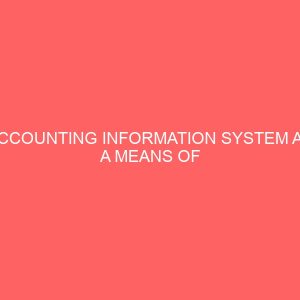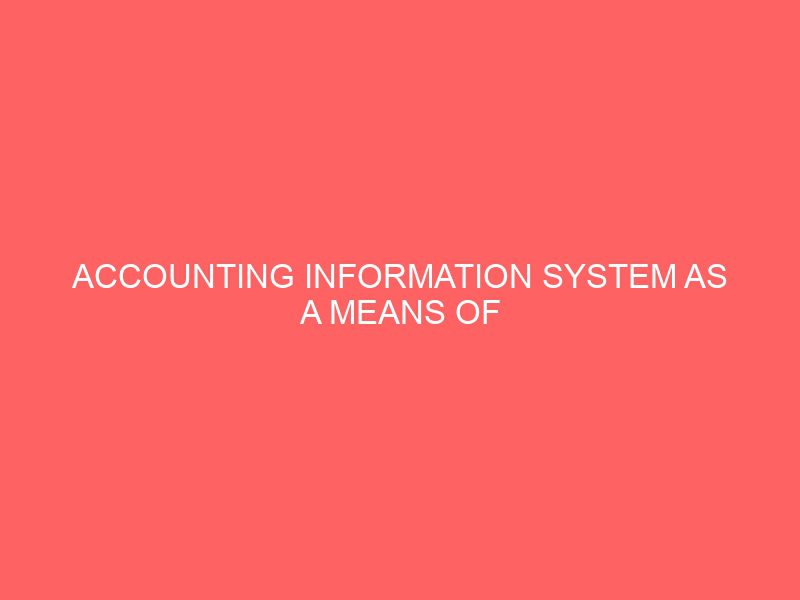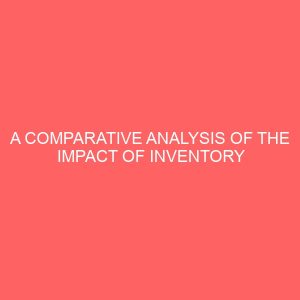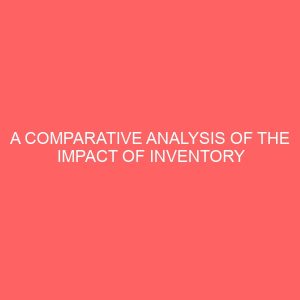ACCOUNTING INFORMATION SYSTEM AS A MEANS OF ENHANCING FINANCIAL MANAGEMENT OF TRANSPORT COMPANY (A CASE STUDY OF THE NIGERIAN RAILWAY CORPORATION ENUGU)
ABSTRACT
Accounting information system in a transport organization has been a great problem to the third world countries in general, which Nigeria as a country has its own share. This research work, Accounting information system in a transport organization, suggests ways of minimizing the effects of the problems of inefficient accounting information. It is believe that an improvement in this regards will enhance the performance of the corporation. To enable the researcher find solution to the problem of this study, some questions were raised in the form of hypotheses, which were developed comprising the null and alternative hypotheses. The methods of data collection were primary and secondary data method. The data collected were analyzed by use of simple percentages while chisquare was used to test the hypothesis formulated for validity. Findings show that accounting information is an indispensible tool in the management of Nigeria Railway Corporation and the activities of unqualified and incompetent accounting officers are responsible for the performance of the accounts departments in Nigeria Railway Corporation. Based on the findings, the researcher concludes that the accountant should put more efforts especially when computing the financial statement since accounts fraud result from ignorant of proper accounting procedures. Since the financial statement are sources of document of accounting information, efforts should be made in generating more relevant, timely, effective and accurate accounting information necessary for prevention or detection of fraud.
CHAPTER ONE
INTRODUCTION
1.1 BACKGROUND OF THE STUDY
The Nigerian Railway Corporation NRC has been in existence for years. It is regarded the largest transport corporation in Nigeria and has a high network operations.
The Nigerian railway corporation is One Hundred and Fourteen years 114 old and it runs a unilaterally designed track system of 1067mm charge gauge. Only 30km of its track distribution is in double track and that is within Lagos area.
Nigerian Railway Corporation actually commenced rail business activities with the construction of the first rail line from Lagos to Ibadan 193m between 1998 and 1901. By 1964 when the construction of 640km KanoMaiduguri rail line, then known as Bornu extension, was completed, the present core of the railway network hard been put in place.
Presently, the railway system is made up of 3505 route kilometers and 4332 track kilometers. In addition to this is the 19km 1067mm gauge extension from PortHarcourt to one deep sea port and the 277km standard gauge rail construction of 1435mm from Ajaokuta to Warri. Nigerian railway was transformed from its first and initial name.
Government Department of Railway to Nigerian Railway Corporation in 1955 through the instrumentality of the statutory act of parliament which, apart from changing the name of the railway industry in Nigeria, equally conferred on it absolute monopoly as the institution recognized by law to carry out railway services.
The general aim and object of the statutory act of parliament of 1955 for Nigerian railway is to recognize same as carrying out its function of effecting carriage of passenger and goods in a manner that will offer full value for money, meet cost of operation, improve market share and quality of services, ensure safety of operation and maximum efficiency, meet social responsibility in a manner that will meet the requirements of rail after, trade, commerce, industry and general public.
The headquarters of the corporation is located at Ebutemetta in Lagos state while the entire network is for administrative convenience, divided into seven autonomy districts viz.Lagos EbuteMetta junction, west Ibadan, north Zaria, east Enugu, Northwest Minna, north central Kanfanchem and Northeast bauchi
The railway system has been undergoing same rehabilitation and modernization with the full political and financial support of the federal government through the federal ministry of transport. The rehabilitation of the railway system includes track spot removal of Lagos to Kano and Maiduguri to portHarcourt, supply of 25 new locomotive engines from brazil south America to boost the registry motive power base of the corporation, up grading of the signaling and telecommunication system from manual to semi automatic, as well as rehabilitation of carriage and wagon workshops, reequipping the workshops, supply of service support spare part consumables, strategic rebranding of the corporation, rehabilitation of stations and marshalling yards inter alia.
1.2 STATEMENT OF PROBLEMS
Nigeria Railway Corporation which dominated the transport sector of the economy in the sixties is presently being delegated by other means of transport such as road transport, sea, and air transport. The corporation has lost her passengers and freight mainly to road transport; this is because of inability of the corporation to compute effectively in order to meet the age longed challenges.
Ordinarily there should have been growth in both road and railway transport but the railway transport seems neglected. The truth of the matter is not just neglected, but a problem of cash flow difficulty and management these affect the purchase of spare parts, repair, payment of salaries, inadequate infrastructure support and enhance service rendering.
Given the above condition of the Nigerian Railway Corporation in the nations transport industry, the problem which looks for detailed analysis and solution includes the following questions.
1. Is the accounting information used in the corporation adequate for managements short and long term plans
2. Have the accounting officers in the corporation has the needed professional skills to cope with demands of the job
3. Is there any serious effort made by the corporation to boost operation
4. Do the accounting officers perform their duties without the interference of the management
5. What is the mode of approaching the chief accounting officer of the corporation
1.3 OBJECTIVES OF THE STUDY
Bearing in mind the above mentioned problem study is aimed at finding out among other things such as:
1. The organization of accounting department in Nigerian Railway Corporation with particular interest in the eastern division of the corporation and how the accounts department contributes to the achievement of overall goals for the corporation.
2. Whether the accounting information is actually one of the effective management tools in the railway corporation.
3. Whether the accountants in the corporation adequately perform their duties in conformity with the statement of accounting standards SAS
4. In where the tools of the accounts department to the performance of the individual workers in term of their output
1.4 RESEARCH QUESTIONS
Despite the problem mentioned above concerning the Nigerian railway corporation, these questions are been asked towards their accounting department.
1. Dose the account department of railway corporation Enugu contribute to the achievement of the overall goals of the corporation
2. Is the accounting information actually one of the effective management tools in the railway corporation Enugu
3. Dose the accountants adequately perform their duties in conformity with the statement of accounting standards
1.5 SIGNIFICANCE OF HE STUDY
The role of accounting information in the management of large business organization cannot be over emphasized. It is based on the fact that the research is to study and appraise accounting information system as a tool of management using the Nigerian Railway Corporation Enugu as a possible ways of minimizing the problem for better and enhanced performance as the corporation.
The knowledge about these problems and their way out will help remedy other transport corporation in similar state. This study is to make recommendation that would boost the operation performance of the account department in the Nigerian Railway Corporation Enugu if being implemented. Beside, the study of this work is to help as well as serve as a term of reference for those who may be interested in using it.
1.6 SCOPE AND LIMITATION OF THE STUDY
This study is on the Nigerian Railway Corporation Eastern division, the limitation of this study in Nigeria railway corporation eastern division Enugu. This is due to some constraints; those constraints were financial difficulties which prevented the running down from one relevant railway corporation division to another for sources of information necessary for this study.
Another constraints are the time limit within my disposal, the demand from the academic activities and limit within this study is to be presented constitute the constitutes
1.7 DEFINITION OF TERMS
FRIGHTS: This is the volume of revenue acquired by all haulage of goods by the good train.
PASSENGERS FARE: This complies of the returns made from ticket sales and penalties by defaulting passengers.
LOLLING STOCK: This include the entire carrying system which is made up of the locomotive engine, coaches, wagons, both covered and uncovered and tanks. They are used in the haulage of goods and in carrying passengers.
LOCOMOTIVE ENGINE: This is the enquire mechanism at the head of the rolling stock that pulls then along the truck in the movement of goods and passengers trains.
Original price was: ₦3,200.00.₦3,000.00Current price is: ₦3,000.00.








Reviews
There are no reviews yet.